Finance Report for Zylla Company: Sources and Appraisal Techniques
VerifiedAdded on 2023/01/11
|8
|1326
|41
Report
AI Summary
This report analyzes the financial strategies of the Zylla Company, a business operating ferries. It explores both short-term and long-term sources of finance available to the company, including debt, equity, and retained earnings. The report then delves into investment appraisal techniques, specifically the payback period, net present value (NPV), and accounting rate of return (ARR), to evaluate potential investment projects. Calculations for NPV and IRR are provided. The report concludes with a summary of findings and recommendations for financial decision-making, supported by references to relevant academic literature.

TASK 4
Paraphrase This Document
Need a fresh take? Get an instant paraphrase of this document with our AI Paraphraser

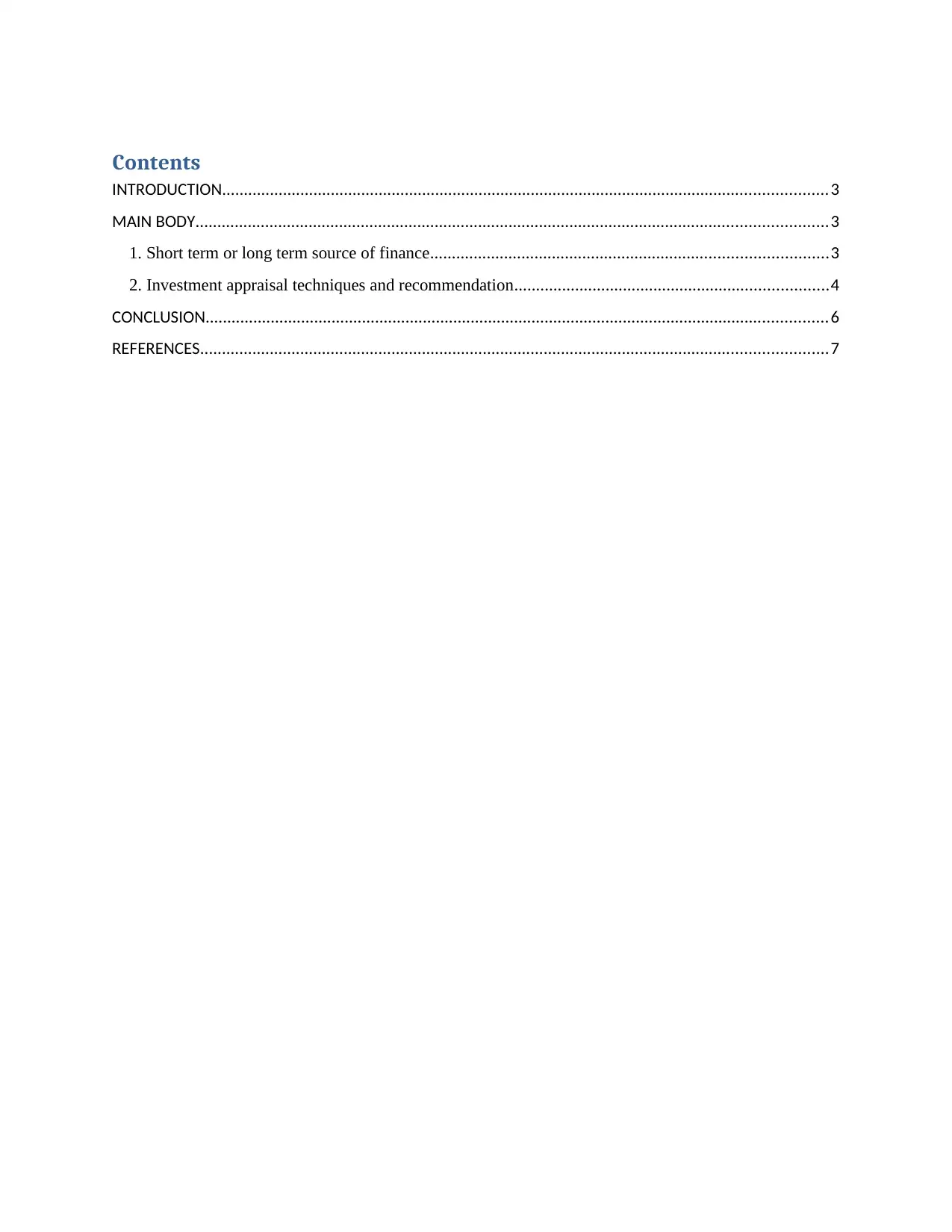
Contents
INTRODUCTION...........................................................................................................................................3
MAIN BODY.................................................................................................................................................3
1. Short term or long term source of finance...........................................................................................3
2. Investment appraisal techniques and recommendation........................................................................4
CONCLUSION...............................................................................................................................................6
REFERENCES................................................................................................................................................7
INTRODUCTION...........................................................................................................................................3
MAIN BODY.................................................................................................................................................3
1. Short term or long term source of finance...........................................................................................3
2. Investment appraisal techniques and recommendation........................................................................4
CONCLUSION...............................................................................................................................................6
REFERENCES................................................................................................................................................7
⊘ This is a preview!⊘
Do you want full access?
Subscribe today to unlock all pages.

Trusted by 1+ million students worldwide
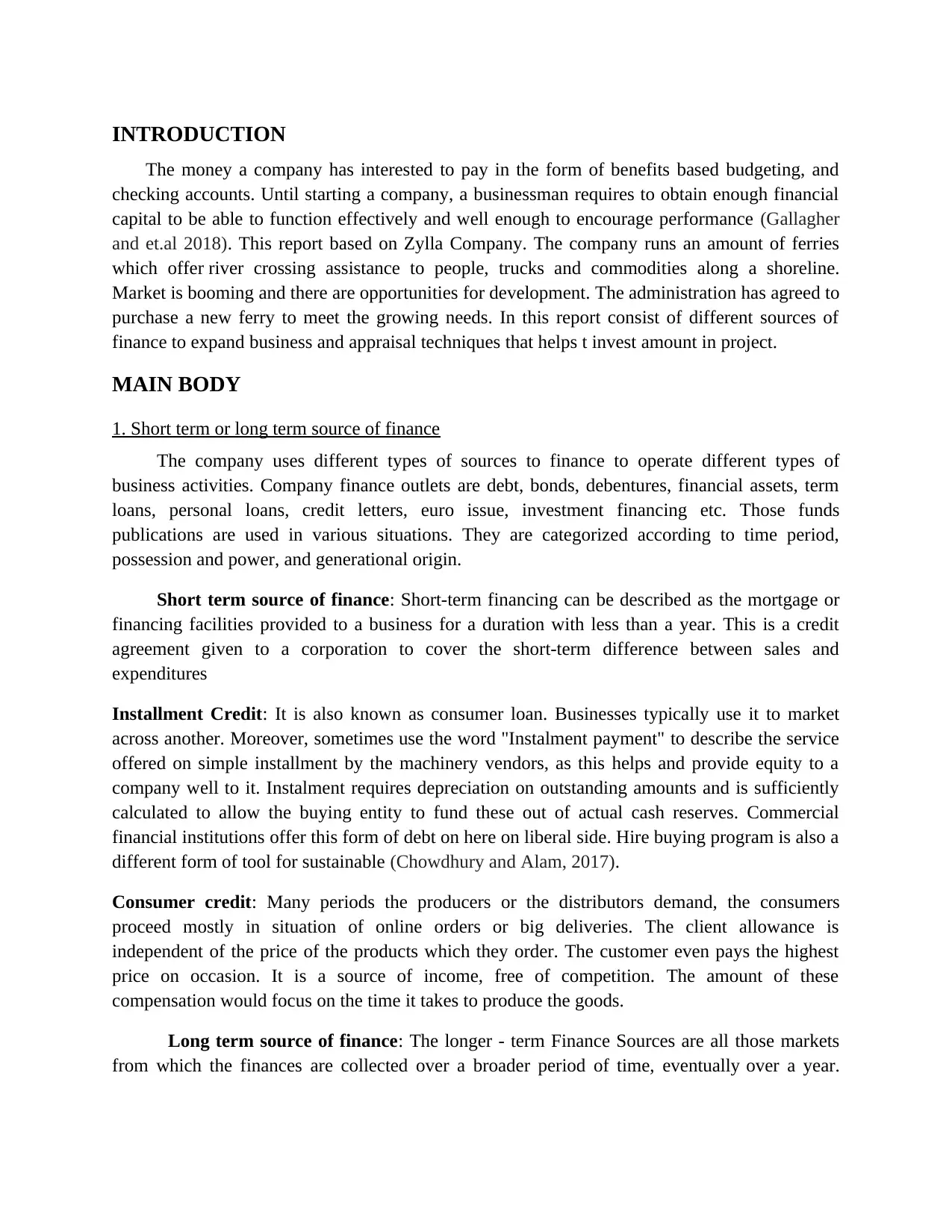
INTRODUCTION
The money a company has interested to pay in the form of benefits based budgeting, and
checking accounts. Until starting a company, a businessman requires to obtain enough financial
capital to be able to function effectively and well enough to encourage performance (Gallagher
and et.al 2018). This report based on Zylla Company. The company runs an amount of ferries
which offer river crossing assistance to people, trucks and commodities along a shoreline.
Market is booming and there are opportunities for development. The administration has agreed to
purchase a new ferry to meet the growing needs. In this report consist of different sources of
finance to expand business and appraisal techniques that helps t invest amount in project.
MAIN BODY
1. Short term or long term source of finance
The company uses different types of sources to finance to operate different types of
business activities. Company finance outlets are debt, bonds, debentures, financial assets, term
loans, personal loans, credit letters, euro issue, investment financing etc. Those funds
publications are used in various situations. They are categorized according to time period,
possession and power, and generational origin.
Short term source of finance: Short-term financing can be described as the mortgage or
financing facilities provided to a business for a duration with less than a year. This is a credit
agreement given to a corporation to cover the short-term difference between sales and
expenditures
Installment Credit: It is also known as consumer loan. Businesses typically use it to market
across another. Moreover, sometimes use the word "Instalment payment" to describe the service
offered on simple installment by the machinery vendors, as this helps and provide equity to a
company well to it. Instalment requires depreciation on outstanding amounts and is sufficiently
calculated to allow the buying entity to fund these out of actual cash reserves. Commercial
financial institutions offer this form of debt on here on liberal side. Hire buying program is also a
different form of tool for sustainable (Chowdhury and Alam, 2017).
Consumer credit: Many periods the producers or the distributors demand, the consumers
proceed mostly in situation of online orders or big deliveries. The client allowance is
independent of the price of the products which they order. The customer even pays the highest
price on occasion. It is a source of income, free of competition. The amount of these
compensation would focus on the time it takes to produce the goods.
Long term source of finance: The longer - term Finance Sources are all those markets
from which the finances are collected over a broader period of time, eventually over a year.
The money a company has interested to pay in the form of benefits based budgeting, and
checking accounts. Until starting a company, a businessman requires to obtain enough financial
capital to be able to function effectively and well enough to encourage performance (Gallagher
and et.al 2018). This report based on Zylla Company. The company runs an amount of ferries
which offer river crossing assistance to people, trucks and commodities along a shoreline.
Market is booming and there are opportunities for development. The administration has agreed to
purchase a new ferry to meet the growing needs. In this report consist of different sources of
finance to expand business and appraisal techniques that helps t invest amount in project.
MAIN BODY
1. Short term or long term source of finance
The company uses different types of sources to finance to operate different types of
business activities. Company finance outlets are debt, bonds, debentures, financial assets, term
loans, personal loans, credit letters, euro issue, investment financing etc. Those funds
publications are used in various situations. They are categorized according to time period,
possession and power, and generational origin.
Short term source of finance: Short-term financing can be described as the mortgage or
financing facilities provided to a business for a duration with less than a year. This is a credit
agreement given to a corporation to cover the short-term difference between sales and
expenditures
Installment Credit: It is also known as consumer loan. Businesses typically use it to market
across another. Moreover, sometimes use the word "Instalment payment" to describe the service
offered on simple installment by the machinery vendors, as this helps and provide equity to a
company well to it. Instalment requires depreciation on outstanding amounts and is sufficiently
calculated to allow the buying entity to fund these out of actual cash reserves. Commercial
financial institutions offer this form of debt on here on liberal side. Hire buying program is also a
different form of tool for sustainable (Chowdhury and Alam, 2017).
Consumer credit: Many periods the producers or the distributors demand, the consumers
proceed mostly in situation of online orders or big deliveries. The client allowance is
independent of the price of the products which they order. The customer even pays the highest
price on occasion. It is a source of income, free of competition. The amount of these
compensation would focus on the time it takes to produce the goods.
Long term source of finance: The longer - term Finance Sources are all those markets
from which the finances are collected over a broader period of time, eventually over a year.
Paraphrase This Document
Need a fresh take? Get an instant paraphrase of this document with our AI Paraphraser
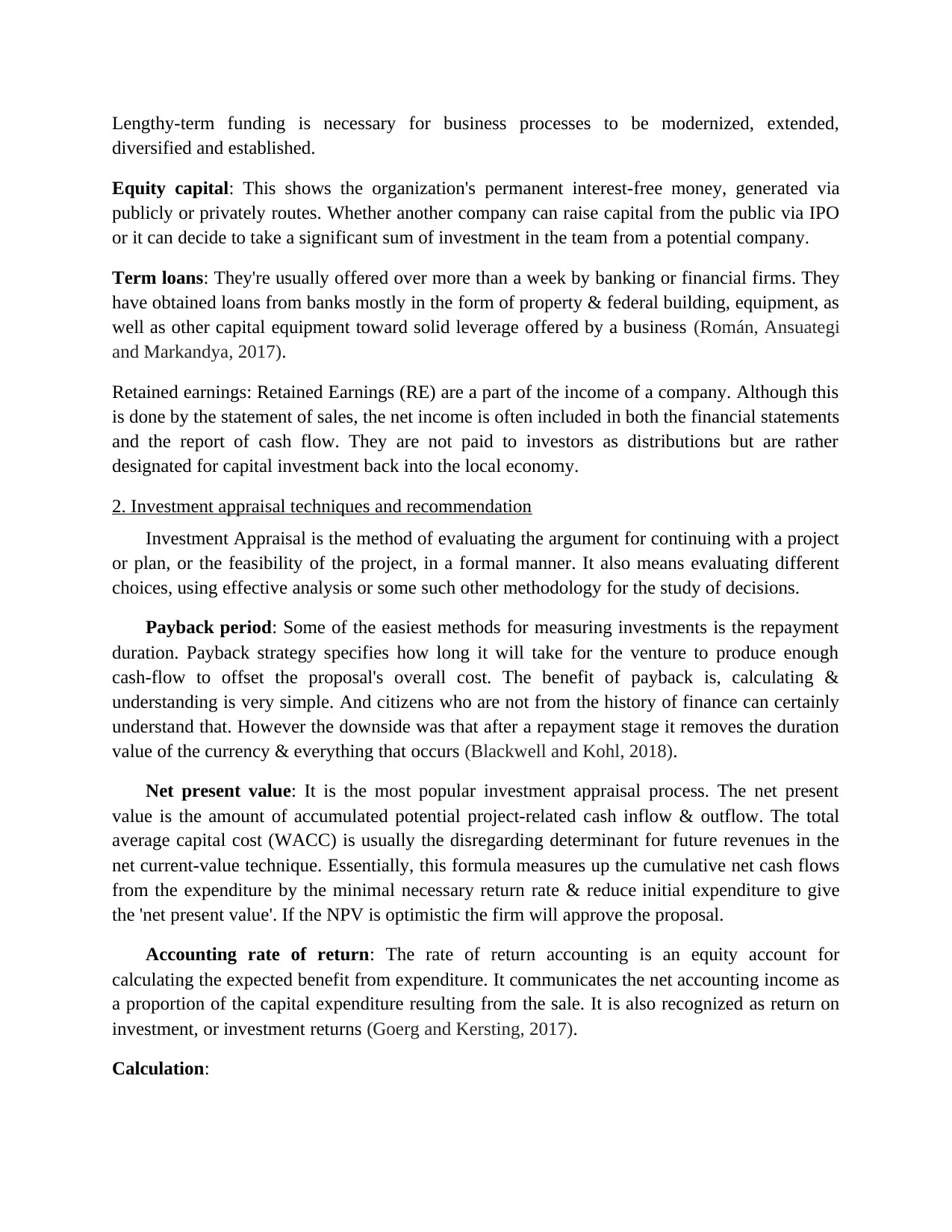
Lengthy-term funding is necessary for business processes to be modernized, extended,
diversified and established.
Equity capital: This shows the organization's permanent interest-free money, generated via
publicly or privately routes. Whether another company can raise capital from the public via IPO
or it can decide to take a significant sum of investment in the team from a potential company.
Term loans: They're usually offered over more than a week by banking or financial firms. They
have obtained loans from banks mostly in the form of property & federal building, equipment, as
well as other capital equipment toward solid leverage offered by a business (Román, Ansuategi
and Markandya, 2017).
Retained earnings: Retained Earnings (RE) are a part of the income of a company. Although this
is done by the statement of sales, the net income is often included in both the financial statements
and the report of cash flow. They are not paid to investors as distributions but are rather
designated for capital investment back into the local economy.
2. Investment appraisal techniques and recommendation
Investment Appraisal is the method of evaluating the argument for continuing with a project
or plan, or the feasibility of the project, in a formal manner. It also means evaluating different
choices, using effective analysis or some such other methodology for the study of decisions.
Payback period: Some of the easiest methods for measuring investments is the repayment
duration. Payback strategy specifies how long it will take for the venture to produce enough
cash-flow to offset the proposal's overall cost. The benefit of payback is, calculating &
understanding is very simple. And citizens who are not from the history of finance can certainly
understand that. However the downside was that after a repayment stage it removes the duration
value of the currency & everything that occurs (Blackwell and Kohl, 2018).
Net present value: It is the most popular investment appraisal process. The net present
value is the amount of accumulated potential project-related cash inflow & outflow. The total
average capital cost (WACC) is usually the disregarding determinant for future revenues in the
net current-value technique. Essentially, this formula measures up the cumulative net cash flows
from the expenditure by the minimal necessary return rate & reduce initial expenditure to give
the 'net present value'. If the NPV is optimistic the firm will approve the proposal.
Accounting rate of return: The rate of return accounting is an equity account for
calculating the expected benefit from expenditure. It communicates the net accounting income as
a proportion of the capital expenditure resulting from the sale. It is also recognized as return on
investment, or investment returns (Goerg and Kersting, 2017).
Calculation:
diversified and established.
Equity capital: This shows the organization's permanent interest-free money, generated via
publicly or privately routes. Whether another company can raise capital from the public via IPO
or it can decide to take a significant sum of investment in the team from a potential company.
Term loans: They're usually offered over more than a week by banking or financial firms. They
have obtained loans from banks mostly in the form of property & federal building, equipment, as
well as other capital equipment toward solid leverage offered by a business (Román, Ansuategi
and Markandya, 2017).
Retained earnings: Retained Earnings (RE) are a part of the income of a company. Although this
is done by the statement of sales, the net income is often included in both the financial statements
and the report of cash flow. They are not paid to investors as distributions but are rather
designated for capital investment back into the local economy.
2. Investment appraisal techniques and recommendation
Investment Appraisal is the method of evaluating the argument for continuing with a project
or plan, or the feasibility of the project, in a formal manner. It also means evaluating different
choices, using effective analysis or some such other methodology for the study of decisions.
Payback period: Some of the easiest methods for measuring investments is the repayment
duration. Payback strategy specifies how long it will take for the venture to produce enough
cash-flow to offset the proposal's overall cost. The benefit of payback is, calculating &
understanding is very simple. And citizens who are not from the history of finance can certainly
understand that. However the downside was that after a repayment stage it removes the duration
value of the currency & everything that occurs (Blackwell and Kohl, 2018).
Net present value: It is the most popular investment appraisal process. The net present
value is the amount of accumulated potential project-related cash inflow & outflow. The total
average capital cost (WACC) is usually the disregarding determinant for future revenues in the
net current-value technique. Essentially, this formula measures up the cumulative net cash flows
from the expenditure by the minimal necessary return rate & reduce initial expenditure to give
the 'net present value'. If the NPV is optimistic the firm will approve the proposal.
Accounting rate of return: The rate of return accounting is an equity account for
calculating the expected benefit from expenditure. It communicates the net accounting income as
a proportion of the capital expenditure resulting from the sale. It is also recognized as return on
investment, or investment returns (Goerg and Kersting, 2017).
Calculation:
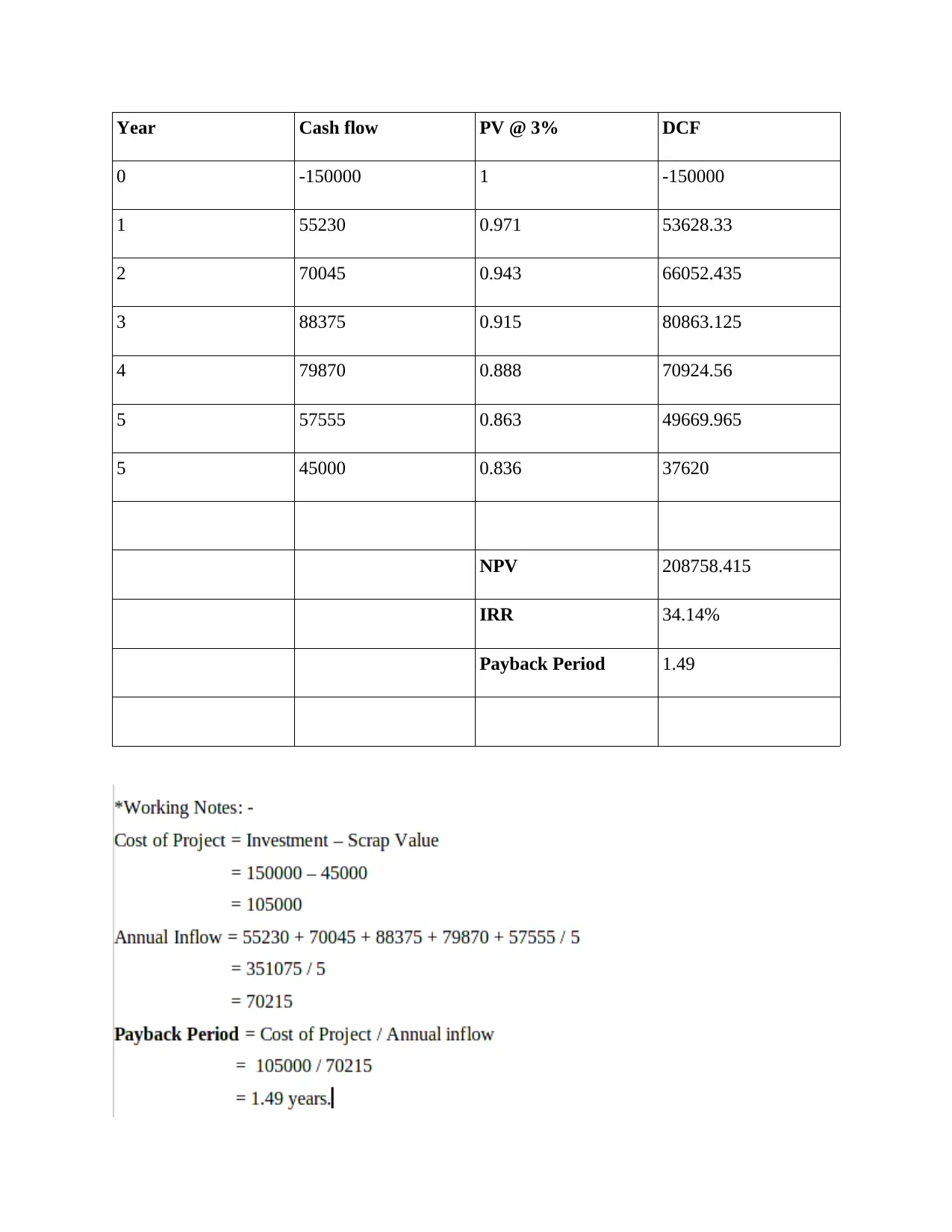
Year Cash flow PV @ 3% DCF
0 -150000 1 -150000
1 55230 0.971 53628.33
2 70045 0.943 66052.435
3 88375 0.915 80863.125
4 79870 0.888 70924.56
5 57555 0.863 49669.965
5 45000 0.836 37620
NPV 208758.415
IRR 34.14%
Payback Period 1.49
0 -150000 1 -150000
1 55230 0.971 53628.33
2 70045 0.943 66052.435
3 88375 0.915 80863.125
4 79870 0.888 70924.56
5 57555 0.863 49669.965
5 45000 0.836 37620
NPV 208758.415
IRR 34.14%
Payback Period 1.49
⊘ This is a preview!⊘
Do you want full access?
Subscribe today to unlock all pages.

Trusted by 1+ million students worldwide

CONCLUSION
As per the above report it has been concluded that to operate any business require to various
types of sources that categories into short term and long ter. These are helping to business to
conduct all the activities in proper manner. To investment to any project require to apply various
types of investment techniques that help to select right project to get better returns.
As per the above report it has been concluded that to operate any business require to various
types of sources that categories into short term and long ter. These are helping to business to
conduct all the activities in proper manner. To investment to any project require to apply various
types of investment techniques that help to select right project to get better returns.
Paraphrase This Document
Need a fresh take? Get an instant paraphrase of this document with our AI Paraphraser
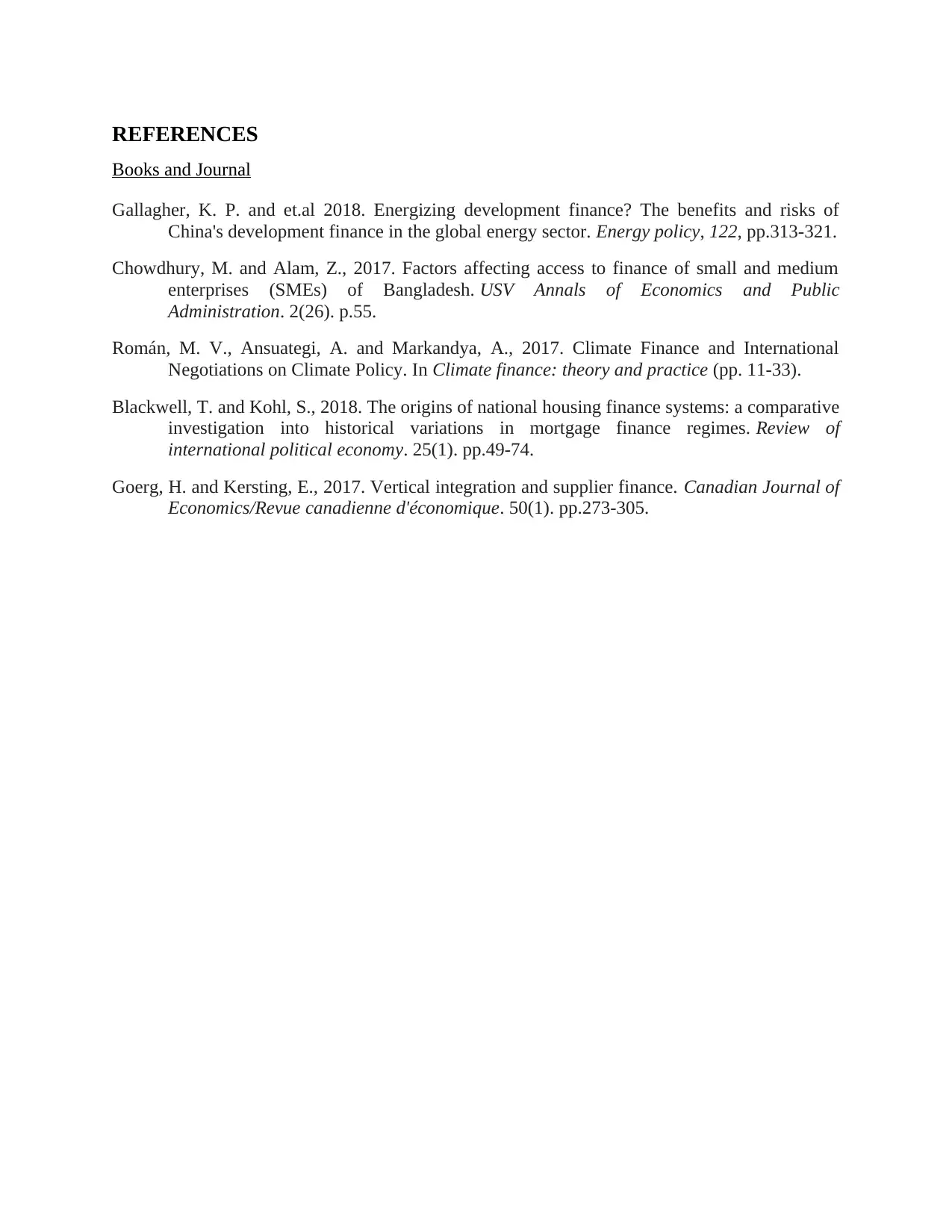
REFERENCES
Books and Journal
Gallagher, K. P. and et.al 2018. Energizing development finance? The benefits and risks of
China's development finance in the global energy sector. Energy policy, 122, pp.313-321.
Chowdhury, M. and Alam, Z., 2017. Factors affecting access to finance of small and medium
enterprises (SMEs) of Bangladesh. USV Annals of Economics and Public
Administration. 2(26). p.55.
Román, M. V., Ansuategi, A. and Markandya, A., 2017. Climate Finance and International
Negotiations on Climate Policy. In Climate finance: theory and practice (pp. 11-33).
Blackwell, T. and Kohl, S., 2018. The origins of national housing finance systems: a comparative
investigation into historical variations in mortgage finance regimes. Review of
international political economy. 25(1). pp.49-74.
Goerg, H. and Kersting, E., 2017. Vertical integration and supplier finance. Canadian Journal of
Economics/Revue canadienne d'économique. 50(1). pp.273-305.
Books and Journal
Gallagher, K. P. and et.al 2018. Energizing development finance? The benefits and risks of
China's development finance in the global energy sector. Energy policy, 122, pp.313-321.
Chowdhury, M. and Alam, Z., 2017. Factors affecting access to finance of small and medium
enterprises (SMEs) of Bangladesh. USV Annals of Economics and Public
Administration. 2(26). p.55.
Román, M. V., Ansuategi, A. and Markandya, A., 2017. Climate Finance and International
Negotiations on Climate Policy. In Climate finance: theory and practice (pp. 11-33).
Blackwell, T. and Kohl, S., 2018. The origins of national housing finance systems: a comparative
investigation into historical variations in mortgage finance regimes. Review of
international political economy. 25(1). pp.49-74.
Goerg, H. and Kersting, E., 2017. Vertical integration and supplier finance. Canadian Journal of
Economics/Revue canadienne d'économique. 50(1). pp.273-305.
1 out of 8
Related Documents
Your All-in-One AI-Powered Toolkit for Academic Success.
+13062052269
info@desklib.com
Available 24*7 on WhatsApp / Email
![[object Object]](/_next/static/media/star-bottom.7253800d.svg)
Unlock your academic potential
Copyright © 2020–2025 A2Z Services. All Rights Reserved. Developed and managed by ZUCOL.




